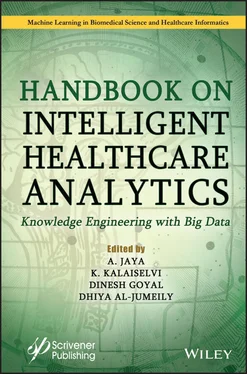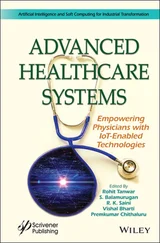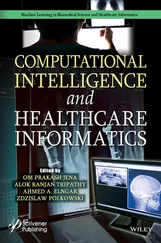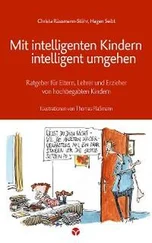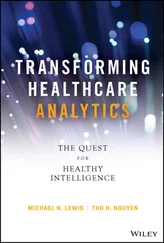Handbook on Intelligent Healthcare Analytics
Здесь есть возможность читать онлайн «Handbook on Intelligent Healthcare Analytics» — ознакомительный отрывок электронной книги совершенно бесплатно, а после прочтения отрывка купить полную версию. В некоторых случаях можно слушать аудио, скачать через торрент в формате fb2 и присутствует краткое содержание. Жанр: unrecognised, на английском языке. Описание произведения, (предисловие) а так же отзывы посетителей доступны на портале библиотеки ЛибКат.
- Название:Handbook on Intelligent Healthcare Analytics
- Автор:
- Жанр:
- Год:неизвестен
- ISBN:нет данных
- Рейтинг книги:4 / 5. Голосов: 1
-
Избранное:Добавить в избранное
- Отзывы:
-
Ваша оценка:
- 80
- 1
- 2
- 3
- 4
- 5
Handbook on Intelligent Healthcare Analytics: краткое содержание, описание и аннотация
Предлагаем к чтению аннотацию, описание, краткое содержание или предисловие (зависит от того, что написал сам автор книги «Handbook on Intelligent Healthcare Analytics»). Если вы не нашли необходимую информацию о книге — напишите в комментариях, мы постараемся отыскать её.
The book explores the various recent tools and techniques used for deriving knowledge from healthcare data analytics for researchers and practitioners. A Handbook on Intelligent Healthcare Analytics
Handbook on Intelligent Healthcare Analytics — читать онлайн ознакомительный отрывок
Ниже представлен текст книги, разбитый по страницам. Система сохранения места последней прочитанной страницы, позволяет с удобством читать онлайн бесплатно книгу «Handbook on Intelligent Healthcare Analytics», без необходимости каждый раз заново искать на чём Вы остановились. Поставьте закладку, и сможете в любой момент перейти на страницу, на которой закончили чтение.
Интервал:
Закладка:
These analytics give the recommendation or suggest action to change the prediction. Prescriptive analytics uses the data, the business intelligence for insight, and the machine learning for forecasting.
Big data analytics perform the above analysis using machine learning, artificial intelligence, and natural language processing to explore the unknown patterns and relationships among data.
3.5 Big Data Applications in the Healthcare Sector
Healthcare sector is the top most sector which generates large volumes of data. So, big data is having a huge impact in the healthcare industry. The EHR of patients is widely adopted and analyzed to get deeper insights on clinical knowledge and for enhanced knowledge about illness and disease. The healthcare organization uses big data that improves the efficiency of healthcare practice and care. Big data with the recent development of data mining techniques, machine learning algorithms, deep learning, artificial intelligence, and image processing used to find many important features. The major applications of big data in the healthcare industry are discussed in the following sections.
3.5.1 Real Time Healthcare Monitoring and Altering
Remote patient monitoring or telehealth is healthcare service for patients and doctors, which use IoT devices to track and analyze health status [25].
The work becomes easy for the doctors and nurses in the hospital because of the application of big data. According to researchers at IBM Watson [2], “Above one million gigabytes of medical associated data is likely to be generated by an average person in their lifetime.” With the new innovations in technology, there is a prevalent use of wearable health monitors. The wearable devices collect data such as temperature, oxygen level, heartbeat, calories burned, BP, water intake, and distance walked. These data can be used by the healthcare professional for the clinical research, monitoring and tracking patients’ health. The sensors are also used with in-patients to continuously monitor the patients. For example, the Fitbit smart watches are used by the patients for self-tracking of their health status. All these monitoring systems are connected to hospitals and physicians through the IoT concept for medical assistance. Table 3.5lists various remote patient monitoring devices with its features.
3.5.2 Early Disease Prediction with Big Data
Predictive analytics is not new to the healthcare industry. But, it became more powerful with the emergence of big data and its tool to understand the gathered data. The predictive analytics in the healthcare sector helps the doctors to predict or for the early diagnosis of the disease like diabetes, heart disease, stroke, and cancer. Disease prediction is the big data automotive tool of the healthcare field. These analyses are used for developing the disease diagnosing process which improves healthcare practices. The patients, medical professionals, pharmaceutical industry, and insurance companies can be benefitted from predictive analytics in healthcare using big data.
Table 3.5 Patient health checking devices.
| Patient health checking devices | Features |
| Glucose checking meter | It used by diabetes patients for checking the glucose level. |
| Heart rate monitoring | It is used to monitor heart rate. |
| Hand hygiene monitoring | It is used in hospital to remind the people to sanitize their hands before entering hospital room. |
| Depression monitoring | It collects information like heart rate and BP and analyzes this information for a patient᾽s mental health. |
| Blood pressure (BP) monitoring | This device monitors blood pressure. Some BP devices take multiple readings for the daily averages. |
| Pulse oximeter | This device is used to track the oxygen saturation level in blood and also the pulse rate of the patient. |
| Patient wearable | Patient wearable devices are used to sense heart rate, blood pressure, glucose levels, weight, and physical activities. |
| Maternity care monitoring | This remote monitoring reduces clinic visits for pregnant women. |
| Electrocardiography (ECG) devices | This device is used to diagnose cardiac abnormalities. |
Predictive analysis mainly used by hospitals:
• To accurate diagnosis of disease
• To reduce healthcare costs
• For preventive medicine
Predictive analyses with medical data are used for determining the risk level of patients for disease based on lifestyle choices and health history.
One example for predictive analytics in healthcare is the predictive analytics algorithm by Kaiser Permanente [4]. This algorithm predicts the infants’ illness using the infant mother’s medical data and medical summary.
3.5.3 Patients Predictions for Improved Staffing
Main big data applications in the medical industry are the patient’s predictions. The prediction of anticipated number of patient’s visits to emergency will improve the staffing and provide a way to utilize the resources of the hospital properly. One of the major problems in hospitals is staffing, that is how many people (doctor, nurse, and other workers) are required at any given time period. Big data is used to solve this problem.
Intel and the Assistance Publique-Hôpitaux de Paris (AP-HP) worked toward developing a cloud based system for predicting the anticipated amount of patient’s visits [3]. The overcrowding is an emerging problem in most of the hospitals. The cloud based big data analytics system will predict the patient visits and the admissions of patients in hospitals as inpatient or in emergency ward. These solutions make it simple for the hospital administration to productively use the resources (staff, beds, etc.) of the hospitals. The advantages of patient’s prediction are improved patient services, reduced wait time, and reduced labor costs, and this will lead to better care with lower cost for patients.
3.5.4 Medical Imaging
Big data analytics for healthcare read the images using algorithms. These algorithms analyze the image by identifying patterns in the pixels and convert it into numbers. The result of the analysis is used by the doctor during the diagnosing process. Because of big data analytical tools, the doctor will analyze the outcomes of the algorithms.
Artificial intelligence is more efficient for the diagnosis of many diseases. One of the examples of AI is diagnosing breast cancer, which is developed by scientists of Google. This diagnosing system uses deep learning algorithm to predict the cancer cells which uses medical images as input [15]. Artificial Intelligence with medical imaging is used in early diagnosis of neurological disease, cardiovascular abnormalities, and cancer cells [30]. Medical imaging with the big data analytical tool and artificial Intelligence is mainly used in the treatment and disease diagnosis process in the early state.
The other big data applications in healthcare industries are as follows:
• Automation of hospital administration process
• Personalized healthcare service
• Medical research and the drug discovery
• Prevent health insurance fraud
• Prevent unnecessary emergency visits of patients
• Practice telemedicine
• Enhance the data security
• Improved strategic planning with the health data.
All the abovementioned applications of healthcare, in big data, can save human lives with more accurate and personalized patient care. The applications of healthcare in big data have a great impact on our lives. The researchers, hospitals, and the physicians are continuously analyzing the vast amount of healthcare data for developing new therapies and for finding new treatments. The innovation in healthcare application is evolving due to continuous development in technologies. The big data application in medical industries helps to prevent pandemic and disease with lower cost.
Читать дальшеИнтервал:
Закладка:
Похожие книги на «Handbook on Intelligent Healthcare Analytics»
Представляем Вашему вниманию похожие книги на «Handbook on Intelligent Healthcare Analytics» списком для выбора. Мы отобрали схожую по названию и смыслу литературу в надежде предоставить читателям больше вариантов отыскать новые, интересные, ещё непрочитанные произведения.
Обсуждение, отзывы о книге «Handbook on Intelligent Healthcare Analytics» и просто собственные мнения читателей. Оставьте ваши комментарии, напишите, что Вы думаете о произведении, его смысле или главных героях. Укажите что конкретно понравилось, а что нет, и почему Вы так считаете.
